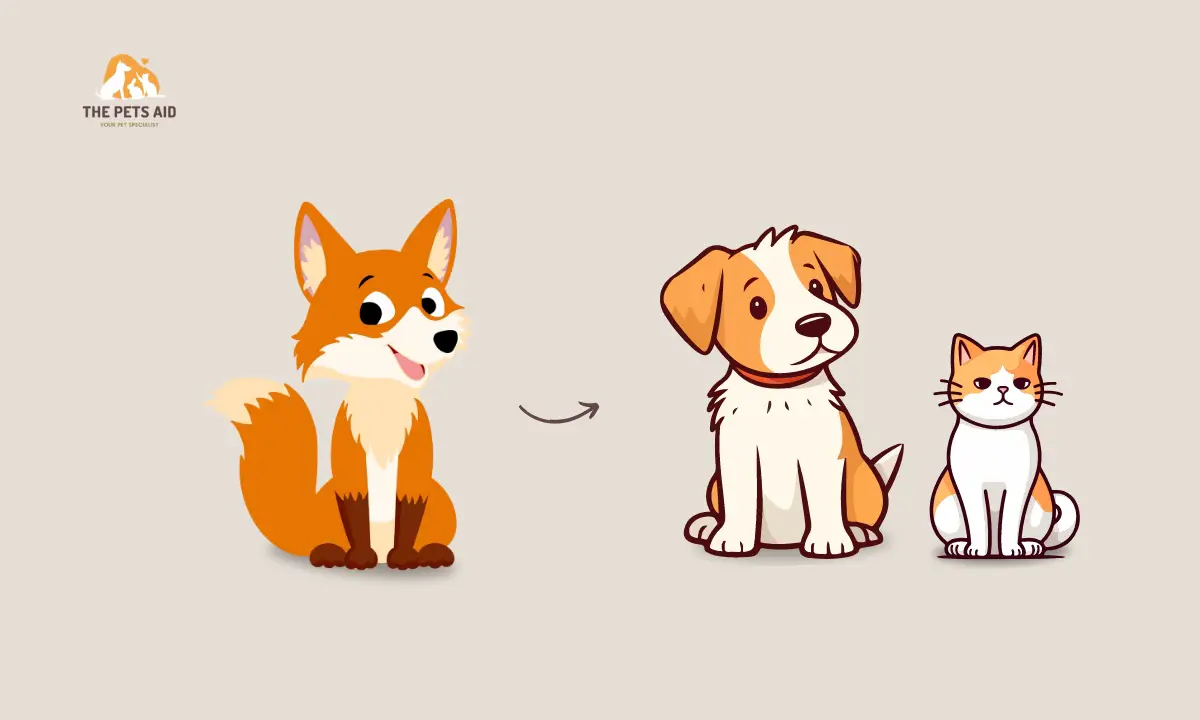Are foxes related to dogs or cats? It’s a question that has intrigued many, and some have even humorously suggested that foxes are “cat software running on dog hardware.”
Today, we’re going to delve into this intriguing topic and discover the true relationships between these animals. While foxes are their own unique species, they share some remarkable similarities with both dogs and cats.

Highlights
- Foxes are closer relatives to dogs than cats, sharing a common ancestor with wolves.
- Foxes and cats have striking similarities, including eye anatomy and hunting techniques.
- Some fox species can make purring-like sounds, showing a desire for affection.
- Foxes have sensitive whiskers and paw features resembling cats, aiding in navigation and hunting.
Foxes and Dogs: Are Foxes Related to Dogs or Cats?
To answer the primary question, foxes are more closely related to dogs than cats. However they share some similarities with both animals, such as hunting techniques and anatomical features like eyes and whiskers.
They share a common ancestor with dogs, which is the wolf. This places them in the same animal family known as Canidae. Despite being different genera and species, foxes and dogs exhibit many shared traits.
Both foxes and dogs are believed to have evolved from wolves. However, foxes branched off from this common ancestor long before dogs did. Dogs have undergone domestication twice in history, dating back thousands of years.
In contrast, foxes evolved into their own distinct species much earlier and have remained predominantly wild. In fact, it’s notoriously difficult to housebreak a fox, a stark contrast to dogs.
Anatomy: Foxes and Dogs

Foxes and dogs also share several anatomical similarities. They both possess snouts and a keen sense of smell, a crucial trait for foxes in the wild, where they rely on their olfactory abilities for hunting. Many wild dogs and wolf-like canids still exhibit these instincts, as they are essential for survival.
History of Cats
Now, let’s briefly explore the history of cats. Cats belong to the Felidae family and comprise over 37 species, mirroring the diversity found among foxes. Domesticated cats are thought to have evolved from tigers, with their genome being 95.6 percent tiger DNA. This genetic connection might explain their often fierce and independent nature.
Interestingly, cats are one of the few species on Earth that cannot taste sweetness. They also have a significantly larger number of neurons in the brain’s central cortex than dogs.
Similarities Between Foxes and Cats

Despite their genetic differences, foxes and cats share intriguing similarities:
- Vocalizations: Baby foxes and kittens both exhibit hissing and spitting behaviors. Foxes can also make noises reminiscent of screeching mountain lions.
- Climbing Abilities: Gray foxes possess the unique ability to climb trees, much like cats.
- Eye Anatomy: Most foxes have vertically slit pupils similar to cats, enabling them to see well in low-light conditions. This adaptation is a result of their nocturnal hunting habits.
- Hunting Techniques: Foxes and cats employ similar hunting techniques, relying on stealth and surprise. Both will pounce on their prey and deliver a fatal blow.
- Postures: Foxes share certain postures with cats, including standing sideways when threatened, with their hair standing on end.
Video: The Absolute Answer
Do Foxes Purr?
While foxes do not purr as loudly as cats, some species can produce purr-like noises when they are excited. Foxes raised in rescues or as pets can be quite outgoing and enjoy attention from their human companions. A purring fox often indicates their desire for affection.
Whiskers and Paws: More Common Ground
Foxes possess sensitive whiskers similar to cats, using them for navigation and detecting objects and dangers in the dark.
Their paws are also reminiscent of cats, with partially retractable claws. Some fox species, like gray foxes, can even use their claws for climbing, a behavior shared with cats and distinct from other members of the Canidae family.
Conclusion
In conclusion, foxes may be more closely related to dogs, but they share fascinating similarities with both dogs and cats. These similarities are a testament to our planet’s diverse and intricate web of life.

